

After nearly 20 years, it’s time for me to leave NASA and do something radically different—help Planet Labs develop world-class satellite imagery. OK, not that radically different. In any case, now is as good a time as ever to point to some of my favorite visualizations. If you’d like like to get in touch with me, drop me a note on Twitter (@rsimmon) or contact the Earth Observatory team—they’ll know where I am.
Thanks to everyone on the Earth Observatory team that I’ve worked with over the years. Among them: David Herring, Kevin Ward, Mike Carlowicz, Paul Przyborski, Rebecca Lindsey, Holli Riebeek, Adam Voiland, Jesse Allen, Reto Stöckli, Goran Halusa, and John Weier.
Let me get this out of the way: this was the first NASA image of an entire hemisphere of the Earth made with full-color data since the Apollo 17 crew returned from the Moon. It’s certainly striking, but once you look carefully a number of flaws start to appear. Flaws that I may or may not have pointed out when I described my design process. (I’ll also reiterate Reto Stöckli’s invaluable work building the land and cloud textures, which were the hard parts.)
Nine: Global Net Primary Productivity
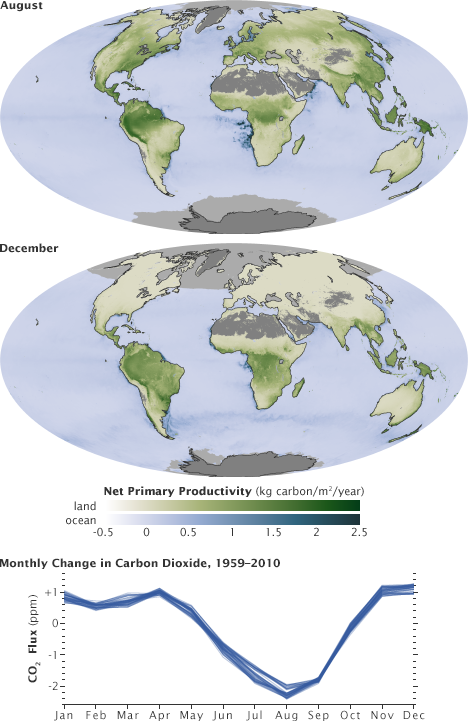
Although these two datasets show the exact same property (net primary productivity, a measure of the amount of carbon the biosphere draws out of the atmosphere) they’re measured in different ways, and deserve to be differentiated. By using palettes with different hues but an identical range of lightness and saturation, they are directly comparable but remain distinct from one another.
Eight: The Landsat Long Swath
[youtube 8nboMGGdXUc]
Shortly after launch, Landsat 8 collected what was probably the single largest satellite image ever made. Roughly 12,000 pixels wide by 600,000 pixels tall the image combined 56 individual Landsat scenes into a single strip from Siberia to South Africa.
Back when I used to be competent at 3D, I made this illustration showing how a pulse of laser light can measure the structure of a forest canopy.
Six: Air Quality over 16 Megacities
It may just be that I’m enamored with Alberto Cairo, but I’m growing increasingly fond of slope graphs. They occasionally tell stories more clearly than more conventional graph types.
Five: an Erupting Volcano from the International Space Station

When Sarychev Volcano blasted a column of ash high above the Kuril Islands an astronaut captured not one, but a whole sequence of photographs of the plume. Make sure you look for the pyroclastic flows coursing down the side of the volcano. (The eruption did not blast a hole in the clouds by the way, that’s a result of interactions between wind, clouds, and island topography.)
I’ve probably worked on more than 1,000 Landsat images over the course of my career. This scene of offset folds in Xinjian China is the best.
I think this map of vegetation in South America was the first original color palette I really got right.
Two: The Original Earth at Night
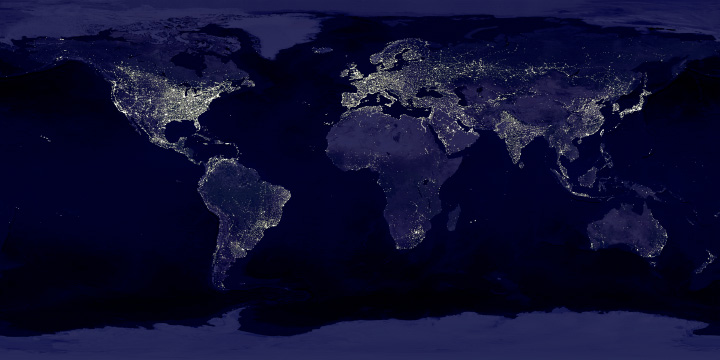
For some reason the color and contrast work better in this version (originally published in 2000 to accompany the story Bright Lights, Big City) than any of my attempted remakes. This includes the 2012 Black Marble, which was made with much better data.
One: Seeing Equinoxes and Solstices from Space
[youtube FmCJqykN2J0]
I’m generally skeptical of animation in data visualization, but for some things motion is the story. I think this applies to the apparent motion of the sun over the course of a year, alternately lighting the North and South Poles. (Apologies for the poor quality of the YouTube compression. Make sure you check out the HD version.)
Finally: Thanks to the NASA family, and to all of you who’ve expressed appreciation for my pictures over the years.
(Repost of an article on the Exelis Vis Imagery Speaks blog.)
One of the most interesting new capabilities of the NOAA/NASA/DoD Suomi-NPP satellite is the Day-Night Band. These detectors, part of the Visible Infrared Imaging Radiometer Suite (VIIRS), are sensitive enough to image Earth’s surface by starlight. The Day Night Band is both higher resolution and up to 250 times more sensitive than its ancestor, the DMSP Operational Linescan System (OLS).
Applications of the Day Night Band include monitoring warm, low-level clouds, urban lights, gas flares, and wildfires. Long-term composites reveal global patterns of infrastructure development and energy use.
Over shorter times scales (Suomi-NPP completes an orbit every 100 minutes or so) multiple Day Night Band scenes stitched together show a snapshot of the Earth at night, like this view of South America, including the 14 Brazilian World Cup cities.
Marit Jentoft-Nilsen and I used a number of software tools to read, stitch, project, and visualize the data, starting with a handful of HDF5 files. VIIRS data is aggregated into granules, each acquired over 5 minutes. These files are distributed, archived, and distributed by NOAA’s CLASS (the Comprehensive Large Array-data Stewardship System). To deal with the unique projection of VIIRS, I used ENVI’s Reproject GLT with Bowtie Correction function to import the data. (If you’re unfamiliar with VIIRS data, now’s a good time to read the Beginner’s Guide to VIIRS Imagery Data (PDF) by Curtis Seaman of CIRA/Colorado State University.)
So far so good. Of course the data is in Watts per square meter per steradian, and the useful range is something around 0.0000000005 to 0.0000000500. With several orders of magnitude of valid data, any linear scale that maintained detail in cities left dim light sources and the surrounding landscape black. And any scaling that showed faint details left cities completely blown out.
To make the data more manageable, show detail in dark and bright areas, and allow export to Photoshop I did a quick band math calculation: UINT(SQRT((b1+1.5E-9)*4E15)*(SQRT((b1+1.5E-9)*4E15) lt 65535) + (SQRT((b1+1.5E-9)*4E15) ge 65535)*65535)
It looks a bit complicated, but it’s not too bad. It adds an offset to account for some spurious negative values; multiplies by a large constant to fit the data into the 65,536 values allowed in a 2-byte integer file; calculates the square root to improve contrast, sets any values above 65,535 to 65,535; then converts from floating point to unsigned integer. This data can be saved as a 16-bit TIFF readable by just about any image processing program, while maintaining more flexibility than an 8-bit file would.
The final steps were to bring the TIFF into Photoshop, tweak the contrast with levels and curves adjustments to bring out as much detail as possible, add coastlines and labels, and export for the web. The result: Brazil at Night published by the NASA Earth Observatory on the eve of the World Cup.

Last week I had the privilege of helping judge the 22nd Malofiej Awards. Presented by the Spanish Chapter of the Society for News Design, Malofiej 22 recognized the best news infographics of 2013. (For the uninitiated, infographics aren’t limited to those posters illustrating tenuously related facts with a handful of pie charts. A good infographic is an information-rich visual explanation; often incorporating illustration and text, but sometimes they’re as simple as a line graph.)
My fellow jurors for the online competition were an eclectic and brilliant bunch: Anatoly Bondarenko, interactive visualization designer for Texty (a Ukrainian guerrilla news site); Scott Klein, news applications editor at ProPublica, Golan Levin, artist & professor at Carnegie Mellon University; and Sérgio Lüdtke, journalist and professor of digital journalism at the International Institute of Social Sciences. (Good thing I didn’t read these bios before heading to Spain: I would have been more intimidated than I already was.)
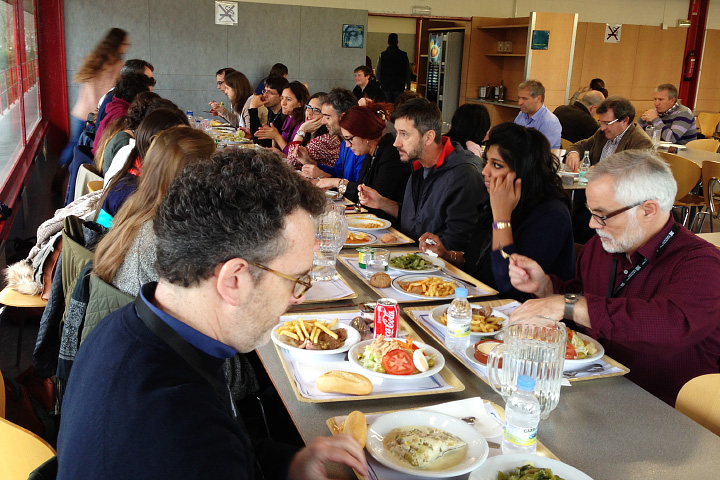
A traditional Spanish lunch for the Malofiej jurors and student volunteers.
For four days we evaluated, discussed, and sometimes argued about 400 or so online visualizations. We first narrowed the field down to about 100, then selected 8 gold, 24 silver, and 39 bronze medals (assuming I counted right). It was interesting to me that we largely liked (and disliked) the same entries, but often for different reasons. This led to several “ah ha” moments, when I suddenly appreciated a new perspective on a figure.
Instead of writing about the golds, which have already garnered their fair share of praise, here are some of my favorite silver and bronze winners.
Silver
China’s Memory Hole: The Images Erased From Sina Weibo (ProPublica)

The beauty of this piece is that the images are the data: images censored from Weibo, a Chinese service similar to Twitter.
Bronze
Electionland (Zeit Online)

I have a few quibbles about this map of the 2013 German Bundestag elections, but it’s a brilliant bit of data crunching and abstraction. Voting districts are positioned based on the similarity of their voting patterns, rather than geography.
Bronze
The federal health-care exchange’s abysmal success rate (The Washington Post)

It’s a slope graph, what more do I need to say?
Of course, if you’re on the Malofiej jury picking awards is the easy part. You’re then on the hook to give a talk to some of the best designers and data visualizers in the world.
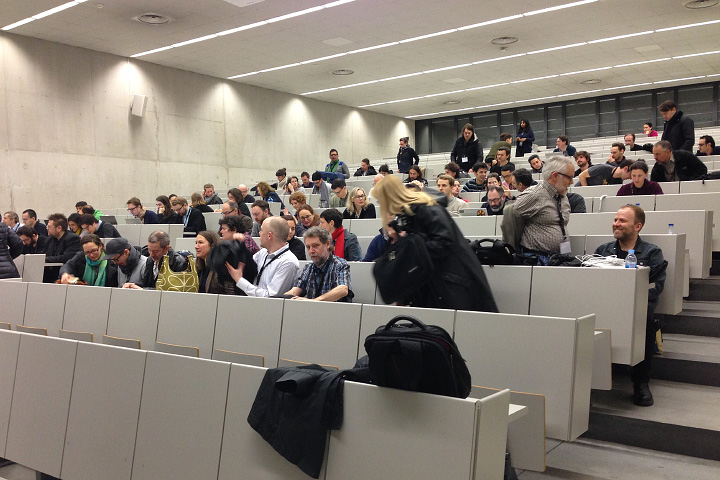
The Malofiej audience.
Jonathan Corum (Two Little Ducks) and Anatoly Bondarenko (Texty on Malofiej-22) gave two of the standouts.
Phew. What a long, exhausting, tremendously rewarding week.
Finally, I’d like to personally thank the student volunteers that functioned as tour guides, travel agents, translators, and personal assistants. They also made sure the online jury got our fair share of chocolate croissants, showed us the best pintxos bars in Pamplona, and even provided tips on surviving a run with the bulls [train, wear white, and run sober (which should’t be that hard, considering it starts at 8:00 a.m.!)]: Carmen Guitián, Alicia Arza, Ann Radjassamy, Beatriz Ciordia, Carmen Arroyo, Carmen Camey, Gabriela Suescum, Kristina Votrubová, Lucía Pérez, Andrés Juárez, Leire Emparanza, María Elena Quiñonero, Mariu Tena, and Alicia Alamillos.
Gracias.
Somehow, a recent conversation on Twitter about tweet density led to a mention of the installation of variable highway lighting in the Netherlands, by way of the 2012 NASA/NOAA city lights map. Which made me wonder—would we be able to see the effects of the new lighting from space? After all, the day night band on the VIIRS instrument is sensitive enough to see by starlight.
According to Philips, streetlights along the A7 from Purmerend (just north of Amsterdam) to Wognum are dimmed 50% after 9 pm. The system was switched on in early 2013, so any change should be visible in 2012 vs. 2013 data:
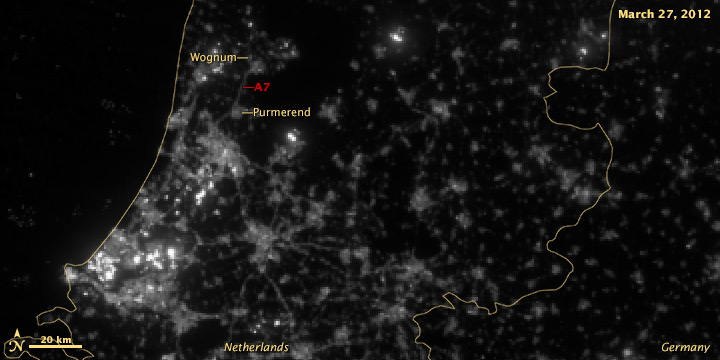
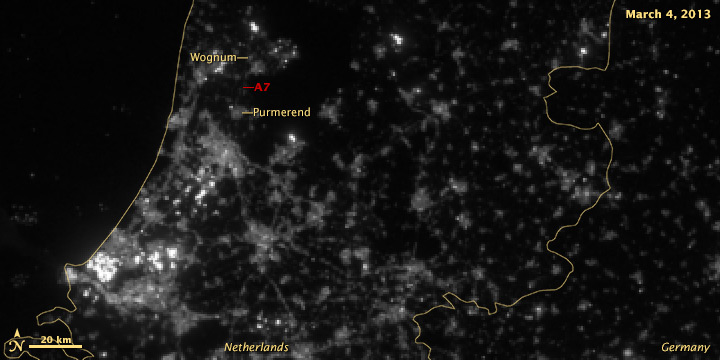
It’s subtle, but the difference is clear.
A wider view of the area reveals more interesting features:
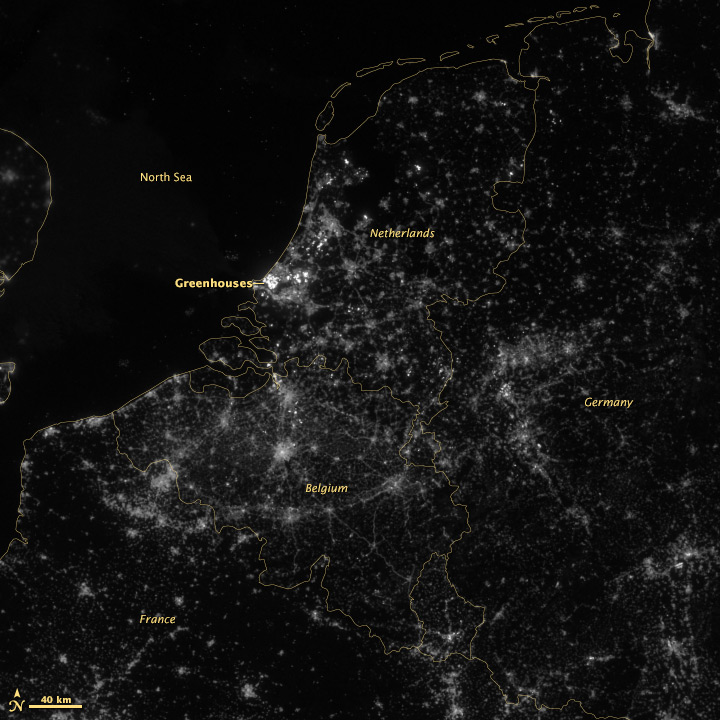
The brightest lights in the Netherlands are from clusters of greenhouses—perhaps growing hydroponic vegetables 24 hours a day. The Netherlands and Belgium are more densely populated and brightly lit than neighboring France and Germany, including their highways. Unsurprisingly water bodies are largely dark, but there is a scattering of boats in the North Sea.
A few notes on the image processing. These data are from the NOAA CLASS system, which is the primary archive for VIIRS data. Unfortunately they’re not in a convenient format: each file is an 80-second chunk of the satellite’s orbit (called a granule), with no preview images. The file format is HDF, which many scientists like but can be (extremely) difficult to read. (This Beginner’s Guide from Colorado State University may be helpful.)
The product is labeled “VIIRS Day Night Band SDR.” SDR means “science data record” which is a calibrated measurement, in this case Watts per square meter per steradian. It turns out this is a very low number, so to visualize the data we multiply everything by 1,500,000,000,000,000 (1.5E15) to make a usable 16-bit grayscale image, which looks like this:
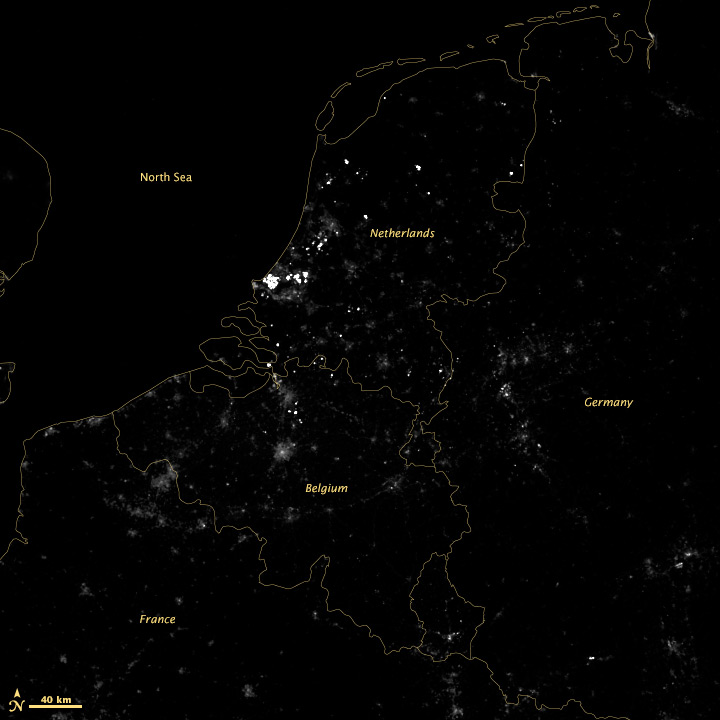
There’s little detail aside from the very brightest lights, so we take the square root of the data to accentuate low values and compress high values—the results of which are in the top images. I usually apply additional contrast adjustments on published imagery, but here I wanted to be more conservative.
Thanks to Gregor Aisch (@driven_by_data), Moritz Stefaner (@moritz_stefaner), Eric Fischer (@enf), and Jan Willem Tulp (@JanWillemTulp) for piquing my interest. My Twitter handle is @rsimmon if you’re interested in data visualization, Earth science, and NASA (with the occasional digression into hockey and dogs). Additional thanks to my colleague Jesse Allen for converting the HDF into something useful.
Update:
Dan W. Williams made a GIF with the 2012 and 2013 images which makes the changes easier to see. Thanks!

Update 2:
By request, here are the full files as GeoTIFFs. You’ll need a TIFF reader that supports floating point (Photoshop does not) to read the “Raw” and “Scaled” data. Photoshop (and even Safari on a Mac) will read the two “Square Root” files.
March 27, 2012
Raw Floating Point
Scaled Floating Point
Square Root 16 bit Integer
March 4, 2013
Raw Floating Point
Scaled Floating Point
Square Root 16 bit Integer
This photo of Skylab was taken by the astronauts of Skylab-2 as they left the space station and departed for Earth on June 22, 1973. More photos from all three Skylab missions are archived on NASA’s Gateway to Astronaut Photography of Earth.
To look through the rest of the Skylab collection, select Find Photos > Search > Mission-Roll-Frame from the menu in the upper-left hand corner of the Gateway to Astronaut Photography of Earth home page. Under Missions pick one or more of SL2, SL3, and SL4, then delete the “E” in the Roll field. Finally, hit Run Query at the bottom of the page. On the Database Search Results page, enable the Show thumbnails if they are available checkbox. Click the number in the Frame column to view a screen-sized image. High-res images are downloadable from each Display Record, just click the View link for the image size you want.
Enjoy.
Japan’s MTSAT-2 (also known as Himawari-7) collected these images of today’s annular solar eclipse from geostationary orbit. The satellite (similar to the United State’s GOES satellites), observed the moon’s shadow as it passed over Australia & the Pacific Ocean. The image sequence begins at 21:32 UTC, with an additional image each hour until 02:32 UTC. The eclipse itself lasted from 22:33 UTC until 02:20 UTC.
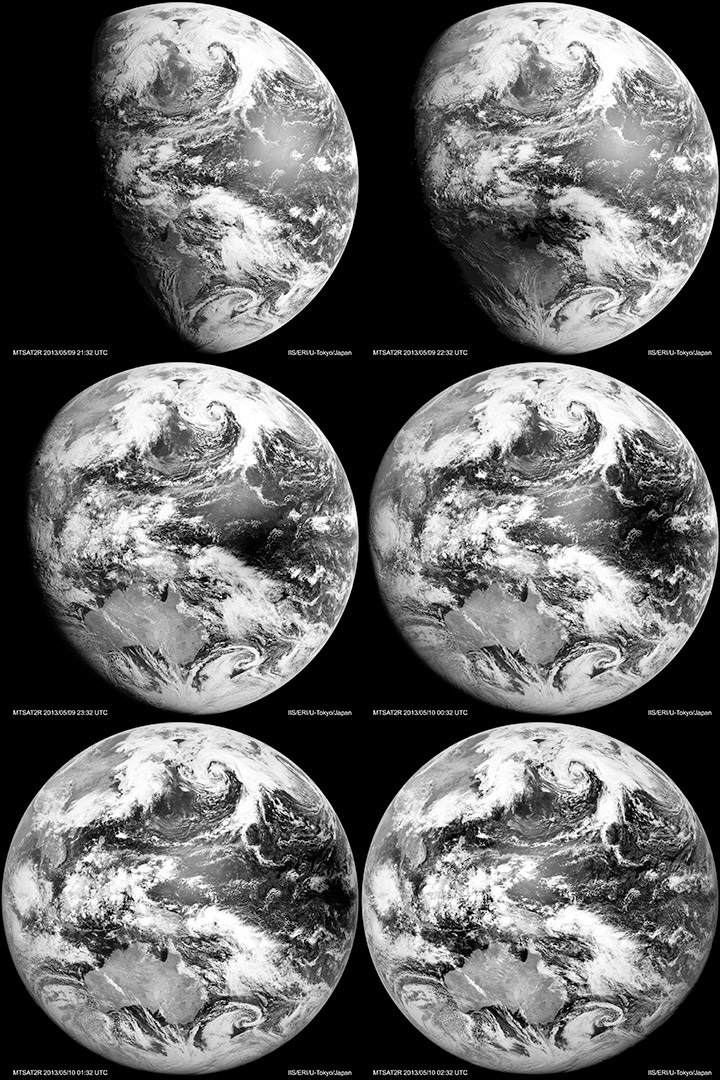
Visible-light & infrared MTSAT images dating back to October 2006 are available from the Earthquake Research Institute & Institute of Industrial Science, University of Tokyo.
Earth Day (8,192 by 8,192 pixels, 9.1 MB JPEG)
Earth Night (8,192 by 8,192 pixels, 4.2 MB JPEG)
Credit: NASA Earth Observatory images by Robert Simmon, using Suomi NPP VIIRS data from Chris Elvidge (NOAA National Geophysical Data Center). Suomi NPP is the result of a partnership between NASA, NOAA, and the Department of Defense.
I (@rsimmon) had a brief exchange this morning about the use of motion graphics in data visualization with Alberto Cairo (@albertocairo) and Andy Kirk (@visualisingdata) which quickly outgrew Twitter’s 140-character limit:

The increasing use of animation (and 3D) in data and information visualization is definitely a trend, but I don’t think it’s a good one. My (possibly naïve) understanding is that motion in data visualization is great for engagement (nothing can capture the attention of the human visual system like motion), but can be a detriment to comprehension. Cognitive science researchers like Barbara Tversky and Richard Lowe discovered that animations—even “well designed” ones—were often less effective than static diagrams at communicating concepts like the inner workings of a British toilet (I’m not kidding) or the movements of a piano action. Motion may get more people to view a graphic, but they may learn less from it.
Don’t get me wrong: recent work by Graham Roberts (thanks Andy!) and many other designers is stunning, and I love working in compositing and 3D software. One of the best visualizations I’ve ever done—a satellite view of the terminator over the course of a year—is animated:
[youtube FmCJqykN2J0]
But animation is typically more difficult and time consuming to produce than static visualization. Even if it’s no worse than a static graphic, is an animation worth the extra expense?
Alberto also touched on the issue of audience: does the general public understand data visualization? On the web that may not be something we have to worry about. Anybody that clicks a link on the Interent is the member of an attentive public—they’re actively seeking information. An attentive person is already interested in a topic, and is usually willing to do the mental work to understand what they’re looking at. (Jon Miller pioneered the concept of attentive publics in his 1983 book, The American People and Science policy: The Role of Public Attitudes in the Policy Process.)
Data visualization is a young field, however, and perhaps we’ll learn how to make beautiful, effective animations quickly & inexpensively. Right now, however, perhaps we should focus on improving more pedestrian information displays.
I’ll be speaking at the upcoming Fall AGU in San Francsico Tuesday morning—8:15 a.m. December 4, room 104 Moscone South. PA21B. Communication of Science Through Art: A Raison d’Etre for Interdisciplinary Collaboration I. (I know, it’s early, but Blue Bottle coffee is close to Moscone Center.)
Art, Aesthetics, Design, And Data: Reaching The Public Through Scientific Visualization
The primary challenge in science communication is attracting a broad audience while maintaining technical accuracy. Scientific topics are often and reflexively considered boring, dry, or difficult by non-scientists. One way to overcome this hurdle and gain the public’s attention is through beautiful and striking imagery. Imaging techniques borrowed from art and design can generate interest in technical or abstract concepts.
NASA’s Earth Observatory routinely uses imagery to communicate current Earth science research. Earth Observatory designers collaborate with NASA scientists to produce imagery using the principles of data visualization. Curiously, the popularity of images tends to be inversely correlated with the scientific content. Simple photographs and illustrations tend to be viewed more often, and more widely shared, than maps and graphs. However, maps of tree density and melt on the Greenland ice sheet are among the most popular images published on the Earth Observatory. These graphics share some features both with each other and our most-viewed natural-color images: clear, relatable themes, intuitive color palettes, and a clean aesthetic. These similarities may explain their success, and provide a roadmap for future data-rich visualizations that engage viewers while communicating complex science.
Please stop by. In addition, I’ve spent the past few weeks putting together imagery for a NASA/NOAA press conference Wednesday morning about a new, very cool sensor on the Suomi NPP satellite, and I’ll be on-hand to answer questions afterwards.
Earth at Night
Wednesday, 5 December
10:30 a.m.A new cloud-free view of the entire Earth at Night, courtesy of a joint NASA-NOAA satellite
program called Suomi NPP, will be unveiled at the press conference. This image is an order of
magnitude more detailed than the wildly popular earlier Earth at Night image, and reveals new
information scientists are using to study meteorology, natural and human-caused fires, fishing
boats, human settlement, urbanization and more. Scientists will discuss the advancements now
possible with these new images and detail a few examples of the features mentioned above – plus
present images of Earth on moonless nights, lit only by “airglow” and starlight, as well as the
vast difference moonlight makes on the Earth’s surface.Participants:
James Gleason, NASA Suomi NPP project scientist, NASA Goddard, Greenbelt, Maryland, USA;
Christopher Elvidge, lead of the Earth Observation Group, NOAA’s National Geophysical Data Center in Boulder, Colorado, USA;
Steve Miller, senior research scientist and deputy director of the Cooperative Institute for Research in the Atmosphere (CIRA), Colorado State University, Fort Collins, Colorado, USASessions: A54F, IN33C
If you’re interested I’ll be sending out some of my impressions of the meeting via Twitter: @rsimmon hashtag #AGU12
I’d also love to meet any Earth Observatory readers who are attending—I’ll try to hang around after each of these sessions, or you can send a message through the Earth Observatory contact form:
http://earthobservatory.nasa.gov/Contact/
Be sure to pick the “Design Feedback” topic (otherwise it won’t go to me, but to our harried developer), and leave your email address.
Active since 2006, Batu Tara continues to puff away. A thin volcanic plume streams northwest from the cloud-shrouded volcano. The Advanced Land Imager (ALI) aboard the Earth Observing-1 (EO-1) satellite collected this natural-color image on June 21, 2012.
NASA image By Jesse Allen and Robert Simmon using EO-1 ALI data.